Studying the Impact of Indian Patriotic Advertisements on Brand Building
Dr. Jaya Surjani[1]
Poorvi Saxena[2]
Abstract : When we are celebratingAzadi ka Amrit Mahotsav on the occasion of 75 years of Independence. India, from the very beginning has uncountable cultures, traditions, religions, languages and people and all are united by a single term and that is INDIAN. The relationship of Indians with India is same like a mother have with her child. Patriotism is a feeling that can’t be framed into words; every Indian can feel it but can’t express it. Every Indian expresses their patriotism in different ways and different roles, but in the recent year’s patriotism become a regular/common theme for the advertisers/brands to appeal the consumers, where they seems like a patriot who thinks about the country, its growth and improvement and in end tries to build their brand as well. This study analyzes advertisements on patriotic themes and how they are impacting on brand building, what is the meaning of patriotism in these advertisements, relationship between the advertisement and product features, at which time period these ads are telecasted the most, and the recall value it creates for the brands, these are the some objectives that has to be achieved. The research study examined 7 advertisements centered upon the theme of patriotism and what is its impact on brand building. These advertisements included following brands that are TATA TEA, CADBURY, PARLE-G, UNITED COLORS OF BENETTON, TATA SALT, PATANJALI, AMUL. The study concludes with the result that Brands mainly uses Patriotic theme in their advertisements to generate awareness about a particular issue and to maximize their sales and profits.
Keywords – Patriotism, Patriotic Advertising, Brand, Product recall and Brand Building.
Introduction
Humans are profoundly social beings. Cooperation plays an important role in the evolution of the human species. Human being evolves and improves themselves by living in groups. This experience of group living serves as the basis for the emergence of patriotism. The word Patriotism derives from a Greek word Pater which means “father”. On the basis of word Pater, emerged the Greek word patriot which means “a fellow countrymen” and the word Patria which refers to “a fatherland” and “a country”.
The character or passion of a patriot; love of or zealous devotion to one’s own country. (Oxford English Dictionary, 1933).
Patriotism means a noble sentiment of love, pride, and sacrifice for the sake of one’s country and its people. A person who supports his/her country, and is prepared to defend it against enemies or detractor is known as Patriot. The passion of patriotism is said to be flow in the blood of countrymen.
Patriot, as mentioned above a person who supports his/her country and is prepared to defend it against enemies. Almost every person living in a country are seems to be a patriot and their ways and roles to showcase the patriotism are also different. Like in the colonial period where India was struggling to get the freedom from Britishers, there were some patriots like Mahatma Gandhi, Bal Gangadhar Tilak, Pandit Jawaharlal Nehru, Bhagat Singh, Sardar Vallabhbhai Patel, Chandra Shekhar Azad and many more they all fought for India’s freedom but in their own different ways, and that’s what patriotism is all about. Not only this, Indian Soldiers is the best example of patriot, highly scrupulous, positively secular, completely apolitical, and with simple needs and frugal habits. They are the inspiration of today’s youth; they are playing their role of patriotism to protect the country and its residents. Then we have seen in the period of pandemic, all doctors and nurses come to us as a boon as well as all he scientists who develop Vaccine for not only India but for all the world and this shows their devotion/patriotism towards the country. Mangalyaan and recently launched PSLV C54 (Polar Satellite Launch Vehicle) by ISRO is also an example of devotion/patriotism towards the country.
Recently patriots come in the form of Brands. Brands who portray a story of patriotic theme and try to evoke the patriotism of consumers and they also wish to sell their product as well. Brands usually show themselves as patriots when any national occasion arrives or something patriotic happened in the Nation.
It is being noticed that after and during the pandemic period, the percentage of patriotic themed advertisements has increased, as it was also necessary because it was the call for that time. But before this pandemic period these advertisements usually come on national occasions like Independence Day and Republic day and now the brands and agencies become so competitive and have neck to neck competition that they are just copying one’s idea and pasting it onwards.
In the series we’ll be talking about Patriotic Advertising. Patriotic Advertising better is termed as Patriotic Marketing, where Brands uses patriotic themes and makes strategies to convey a sense of national pride and appeal more extensive consumer base by targeting their patriotic sense through using images, slogans, videos, and taglines. Patriotic Marketing includes many of its forms such as, Use of Patriotic colors videos and images during the advertising of the product and also in the packaging process of product. Give the product a name which is directly or indirectly related to nation, patriotism and national pride. Use of National Raw material in the manufacturing process of the Product. Brands availing special offers and discounts on the national occasions or especially providing these to active duty military personnel and veterans to convey them a sense of strong patriotism from the company/brand. Patriotic marketing positioning process follow INDIA approach where (Avinash Kumar Mishra, 2021)
I – Stands for Indian-ness, finding an Indian element in the product be it name, slogan, logo color, or tagline.
N – Stands to narrate the Narratives, once the Indian element is found in this step brands tries to develop an emotional connect with the consumers to communicate.
D – Stands for delivering through Digital, this become necessary for the brands to communicate and portray themselves to their target audience and it can be best done with the social media platforms.
I – Stands for integrate to Involve, here brands involve themselves with different CSR activities and make connections with various Non-Governmental Organizations (NGOs) to show that they are not only talking and also taking actions in the ground level to uplift the nation.
A – Stands for assess to Adopt, brands need to continuously assess their communication so that they can’t go obsolete.
When we start discussing about what is a brand, we often end this discussion by saying that Brand is a product, service or concept developed by a company publicly and have a USP that makes it different from the other products in the market. But wait for a while a Brand is more than that, it’s a sum of perceptions that are held for a company, product or services by its consumers or customers or it’s a person’s emotional perception – a gut feeling for a company, product or services which can be positive and negative and which ultimately shows that it’s the consumers who own the product or service and not the company.
Brand building is another term that is frequently used by advertisers, here I am just giving a brief of Brand Building and it’s a process of building a good brand. The foundation of a good brand is always Trust, trust that is developed by a company for its product or services. Trust for the product will developed or not it is only in the hands of the consumers, one’s the consumers used the product the confusion for trust building will get clear, if the consumer buy the product once again it will show a clear picture of trust development for the product while if he get switches to another product then the previous product doesn’t win the trust it should.
A research technique called content analysis is used to identify the existence of specificwords, topics, or concepts in a given set of qualitative data (i.e. text). Researchers canquantify and examine the occurrence, significance, and connections of such specific words,themes, or concepts using content analysis. For instance, academics can assess the languageused in a news story to look for partiality or bias. The meanings contained in the texts, theauthor(s), the audience, and even the culture and time period surrounding the text can all beinferred by researchers.
Parameters for Content Analysis of this study
- Composition
- Connotation
Review Of Literature
1. According to “Gunjan Sharma, Brand Building and Nationalism: A Study on the Commercial Message in Indian Advertisements” she citied “When a nation’s patriotic feelings are evoked for commercial gains, it is called Commercialization of Nationalism or consumer nationalism” and “When the nation becomes a medium to sell a product, then the whole idea of the nation – everything it constitutes and everyone who adheres to it – becomes subservient to the vicious circle of capitalism. This creates a facade of wants by creating an illusion of incompleteness, scarcity and need, by utilizing the rhetoric mentioned above. It also reinforces the material basis of emotions like nationalism by defining them in their exteriority and their tangible manifestation. Lastly, it also turns nationalism into a product to be sold in the market.”
According to this research here, regarding consumer nationalism ,brands are using nationalism as a source of brand building and is not restricted to any specific product/service category or corporate and brands also get successful in their motive because consumers get a sense of self-fulfillment by supporting the most visible from of nationalism, but they are unaware of the fact of capitalism,
2. According to “Madalina Moraru, Patriotism in Romanian Advertising – A means to Recover National Identity”, research analyzes the way advertising messages express patriotism to encourage consumers to accept their own identity, and also reveals the way campaigns successfully appeal to consumers by using local rather than a global strategy.
In his research the conclusions he draws are, there are 3 main reasons of increased patriotic advertisements in Romanian. First, the economic crisis created the proper context for national products to be branded and promoted, as competition become less active buyers sought more affordable products. Second, global brands attempted to establish a personal relationship with consumers by localizing their campaigns and not solely relying on general messages the way they used to. . In fact, globalization unexpectedly produced a more accurate differentiation that led consumers to rediscover their feeling towards their country. Third, advertisers focused on the local brand concept and tried to convey a homogeneous message according to it, creating a particular, yet various and dynamic profile of the Romanian consumer.
The research establishes that patriotic advertising for Romanian consumers not only express patriotism but also helped them in their difficult time (economic and political crisis) to become aware of their local values and encouraged them to trust authentic products by promoting forgotten patriotic feelings and reactivating the national pride and also encourages brands to follow local strategy rather than global strategy so that consumers feel connected to them, as they are with their roots.
3. According to “Jyoti Raghavan, Brand Unity: Impact of advertisements on Patriotism, Unity and Communal Harmony” tries to explores the reasons behind the popularity of these patriotic themes that also embrace notions of nationhood, communal harmony and national unity in commercials and public service advertisements.
The conclusion that this research paper draws are the prime time telecast and repetition of these patriotic on all major national occasions has given these brands a favorable disposition in the minds of the public. As for commercial products, the amplification factor raises chances for brand notice ability. Patriotism is a theme that advertisers are increasingly turning to for marketing their brands. Such brands are regarded as credible by the public. The bigger the ad blitzes the better the chance of success in branding unity.
The study has shown that emotional advertising through the use of national pride, unity and patriotism serves to evoke powerful emotions among viewers eventually leading to brand recall.
This research paper says that brands uses the patriotic advertisements mainly during the national occasions and that too in prime time in all mediums that enable their target audience to recall the brand easily in turn also improves brand positioning and image. Brands that take support of patriotic themes and advertise are regarded more credible and trustworthy than others.
4. According to “Wan-Hsiu Sunny Tsai, Patriotic Advertising and the creation of the Citizen-Consumer”, in his study tries to explore certain things including the relationship between consumption and citizenship in American culture and to understand how consumers make sense of buy-domestic advocacy and advertising appeals to patriotism. In his conclusion he included that, “the relationship between consumption and citizenship was dramatically reinforced in patriotism-themed advertising. Patriotic ads using American symbols such as the statue of liberty, the American flag, patriotic colors and phrases such as “God bless America” and “United We Stand” began appearing in newspapers within a week after September 11 to showcase companies’ commitment to and pride in the nation (Kinnick, 2003)”. “There are companies toned down the economic aspect and crafted advertising campaigns to express grief, foster national pride and identify the companies as good corporate citizens. One example is Miller’s 2001 television commercial that depicts people from different parts of the country holding signs saying “America the Beautiful,” “Go U.S.A.,” and “We Are All New Yorkers.” In this way, advertising not only served to generate consumer confidence but also instilled the idea that it is one’s fundamental civic duty to continue engaging in consumerism and supporting American brands in particular”.
This research paper, concludesthat the US confronts political and economic turmoil, corporate marketers and political leaders encourage citizen-consumers to shop to keep the economy growing, whereby some of the American Brands through its patriotic advertising seems to increase their sales explicitly but on the other hand, there are also some brands that also doing patriotic advertising but not to increase their sales but as a good corporate citizen whose duty is to play their crucial roles responsibly and portray things that will console the population at that time and ultimately increase their sales. Patriotic advertisements, doesn’t confined to that particular time but are continue to years after so that Americans constantly have the feeling of patriotism.
Objectives
- To study the variables of patriotism used in advertisements.
- To study the link between the patriotic theme and product features/ connection between brand image and patriotic theme
- To study the factorsand release time of these advertisements.
- To study the impact on consumers’ patriotic feeling from these advertisements.
- To study the how brands build themselves through patriotic theme.
Methodology
The methodology used in this Research Paper includes a qualitative analysis of 7 Indian advertisements that are on patriotic theme, and what its impact on their brand building. The Survey was conducted on 50 (sample) selected through random sampling done on college going students of Bhopal city. This sample was collected at one of the highest visited mall of Bhopal. As there were some errors in some answers of the questionnaires the data came from 43 respondents to find out the impact these patriotic advertisements made upon them and were they able to recall these advertisements of the particular brands. The respondents, numbering 43 were young, some of them are college going students and of age group 18-30 years and the rationale behind selection these respondents is quite clear, as they are youngsters and they are the one who get targeted by each and every company/ brand, it is also because India is the country which have maximum youth population in the world. This paper is presenting results in the second part and the data used for this research paper is both primary and secondary.
Qualitative Analysis Of 7 Advertisements On Patriotism-
Video 1 –: #DeshKaKulhad
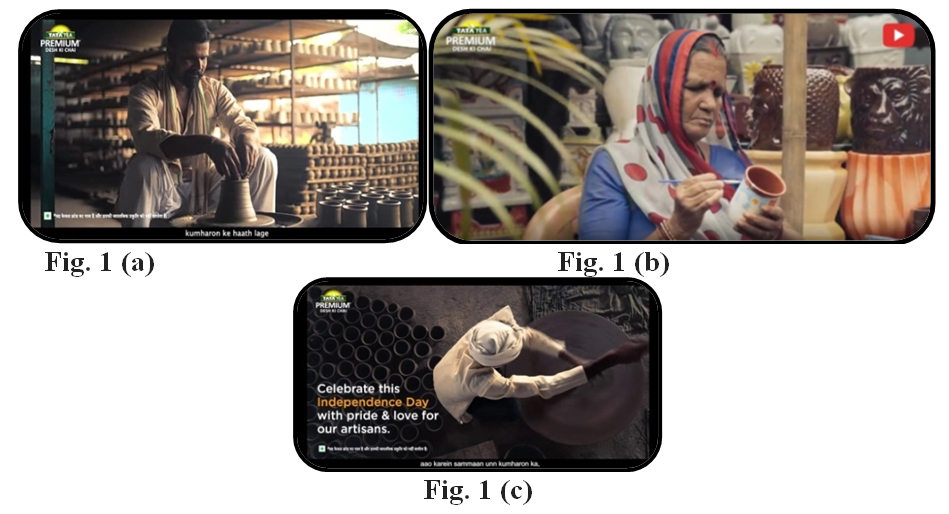
Composition– The above ad of 1.30 minutes was released by Tata tea Premium in 2021, with the partnership with Rare Planet – a start-up that promotes the work of local Indian artisans. The ad represents all the manufacturing stages of the kulhad and it starts with a pottery maker who is working and making Kulhads of chai with a background score and song whose lyrics starts like, ‘mere desh ki mitti hain pyare bas mitti nahi kehlati hain’ and moving forward with further lyrics that it become gold once touched by these artisans and shots of kulhad how it gets prepare at different stages by different local artisans from all around the Nation and also represents the speciality of Indian states.
Connotation– The video depicts the importance and how hardworking & skilful these artisans are regarding their work which got neglected by everyone by thinking it just their mere work, but here Tata Tea not only reminds us their importance, but also celebrate it with pride and love. The ad is very colourful as it contains different designs of the kulhad and shows the happy faces of the artisans which represents their happiness for their skilful work.
Video 2 –: #UnityBar
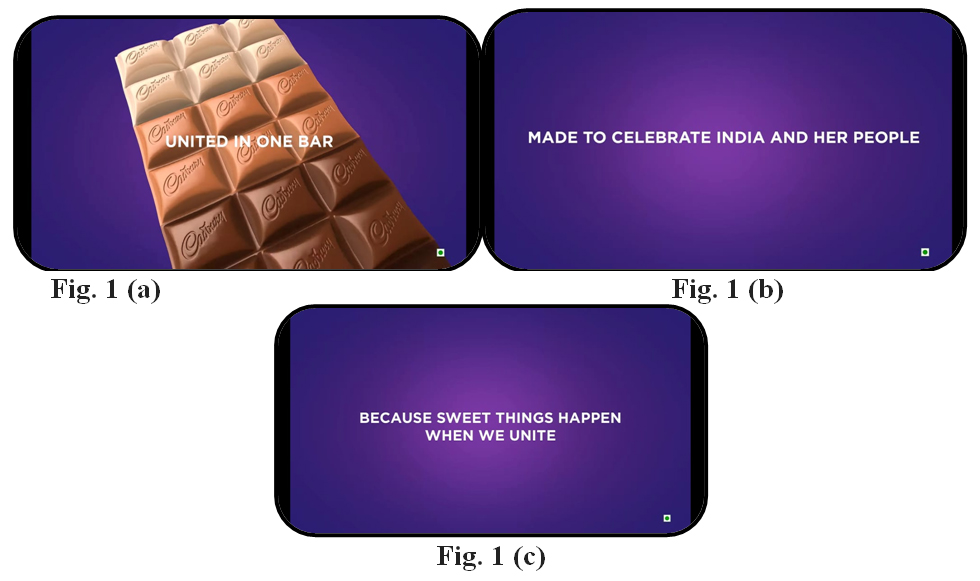
Composition – The abovevideo ad by Cadbury released in 2020 with duration of 25 seconds consists of different frames and it starts with a strong appealing statement ‘India’s first chocolate with’ and move further with the different frames of the chocolate bar which can be seen with written text on the screen in mainly three languages with colour of the bar in the back. The written text includes Dark, Blended, Milk and White with same colours of chocolate in the back and then shows the complete bar with a sentence ‘United in One Bar’. The ad ended up with some sweet sentences ‘Made to celebrate India and her people because Sweet things happen when we unite’.
Connotation – In this advert the very special Cadbury bar – a combination of dark, blended, milk and white chocolate united in one bar, epitomized the common sweetness that defines us in India, even during the not so sweet and difficult times (Covid-19 period). It celebrates our Unity in Adversity – showcasing the inherent sweetness in every Indian that has united us during these tough times. The brand message was also visible in its packaging.
Video 3 –: #YouAreMyParle-G
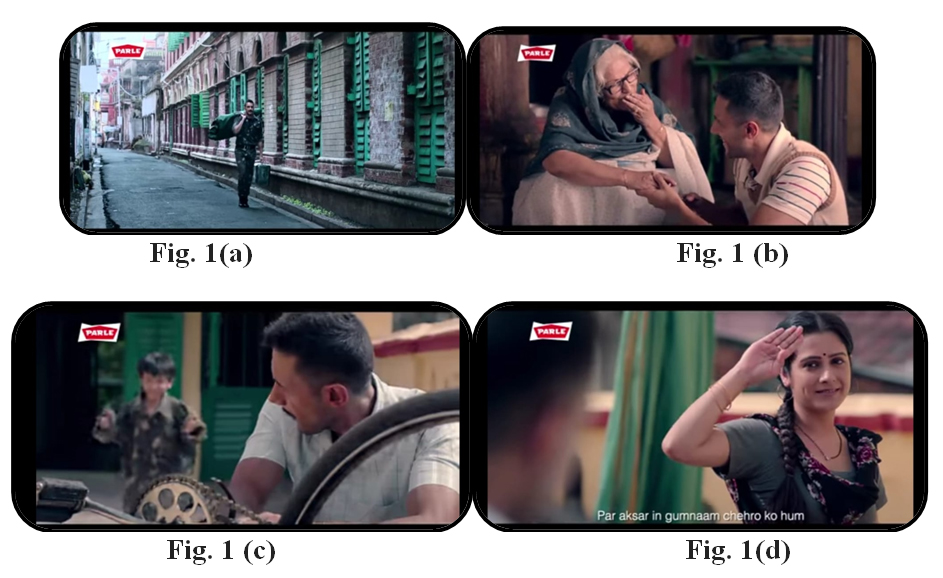
Composition – The ad film is of 2 minutes and 23 seconds, which was released in 2018 represents the home coming of a soldier Ankit Singh and his personal life he only live in his holidays, the ad also shows the strength he and his housemates have. In the following scenes of the ad it also shows the happiness the soldier feels when he is at his home and he fully enjoys it, and the ad ended when the solider is returning to their duty after his holidays. The ad consists of some music and a song that has the ability to evoke the patriotism of the audience.
Connotation – This ad film simply represents the life and struggle of an Indian soldier of how he wishes to live his life with his family but can only fulfil his wish during holidays, it shows the happiest moment for the family when he comes home and the hardest moment when he goes back to his duty. His in between life is the one he never wants to forget about, but when it comes to the nation, he always chooses his nation first over his family.
Video 4 –: #UnitedByHope
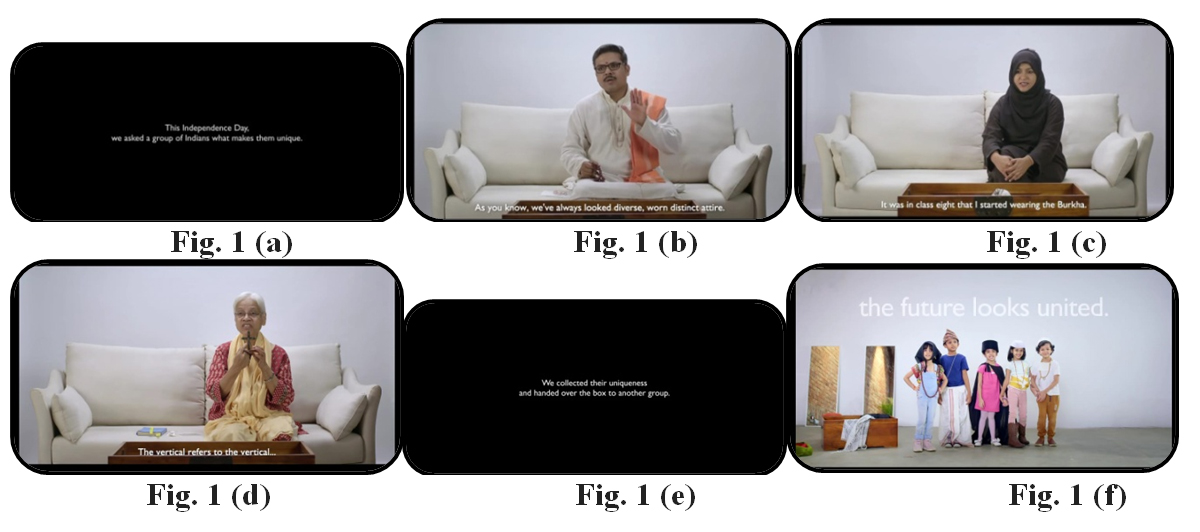
Composition – The above ad came in 2018 with duration of 3 minutes and 25 seconds is a social experiment ad that starts with a question that brand asked to a group of Indians that what makes them Unique, and it moves further with the answers of different religious people and they all place their religious accessories in a box. The box is then given to another group of children and shows how they all use the accessories according to their understanding without knowing their actual meaning. The ad consist bright colours and ended with a sentence ‘The future looks United’.
Connotation – This social experiment #UnitedByHope, featured older India where people talk about the importance of religion and the importance of accessories associated with religion like kada (bangle), pagdi (turban), rosary, burkha etc and compares it with younger India. It highlighted how kids can subtly lead the older generation along the path of unity irrespective of religion or caste and slowly but surely paving the way for a united future.
Video 5 –: #NamakKeWasatye
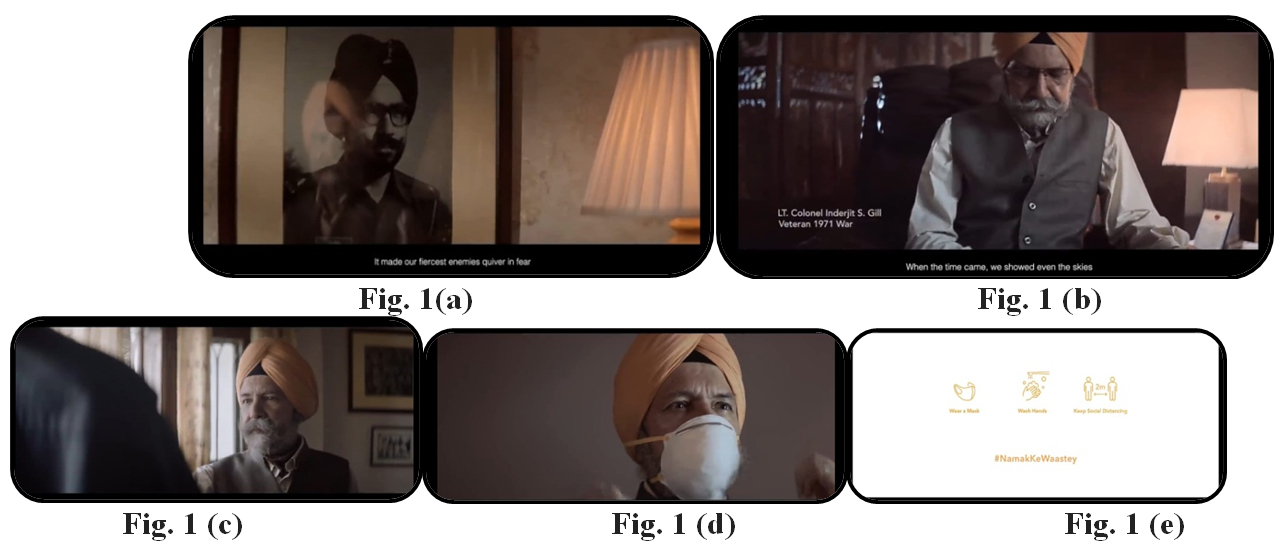
Composition – Tata salt’s #NamakKeWasate ad came in 2020 with duration of 1 minute and 10 seconds. This ad features a Veteran of 1971 war named Lt. Colonel Inderjit S. Gill, with a poem ‘Sarforshi ki tamanna’ by Ramprsad Bismal. In this ad the veteran was remembering the situation in 1971 and they used to fight during that time in which many of them gave up their lives. He then realise the nation is facing a situation which is not less than a war, war with Covid-19, the ad ends up with the veteran wearing face mask and taking precautions while stepping out his home and then all the precautionary measures came on a slide, such as wearing a mask, washing hands and maintaining social distance. The wholesome ad was narrated with a Voice over.
Connotation – The ad urges the nation to unite with the same fiery patriotism as shown during the Indian Independence movement to take efforts in fighting the COVID-19 pandemic. The spirit is brought alive through this ad where the premise of the original poem, ‘Sarfaroshi Ki Tamanna’ by Ramprasad Bismal, featuring a veteran of the 1971 war. The brand appeals to the nation to employ healthy practices such as wearing a mask, washing hands and maintaining social distance.
Video 6 –: #PatanjaliParidhan

Composition – this ad of Patanjali’s Paridhan is an introductory ad by Patanajali that was released in 2019, with duration of 1 minute and 40 seconds. In this ad Patanjali is revealing its entrance in the clothing segment, in the ad it represents the youth with their unique sense of style and fusion and how talented they are. The complete ad is based on music and lyrics and is shoted in Ganga sides and in the streets with a tagline ‘tan man dhan India ban’. The ad ended with a scene where Baba Ramdev was seen leading the younger generation.
Connotation – this ad tells us about the entrance of Patanjali in the clothing sector and it target audience that is clearly visible from the ad is the Younger generation. The ad is made aesthetic with the patriotic appeal and with the exact music sense, the younger generation craves for, so that youngsters will easily targeted.
Video 7 –: #AmulDoodhPeetaHaiIndia
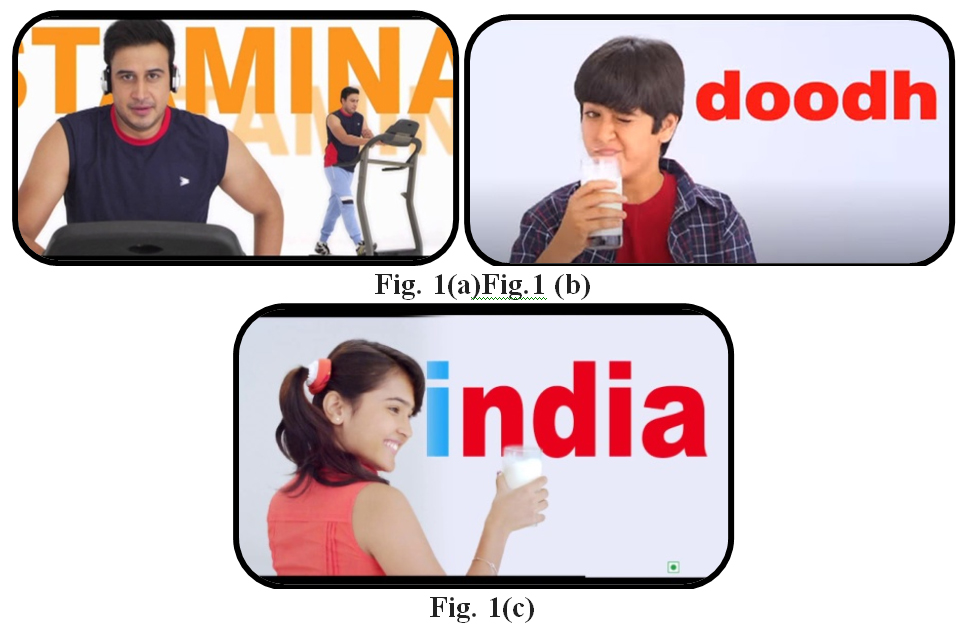
Composition – This ad of Amul came in 2016 and its duration is 31 seconds, the ad displays a range of people from the youngest one to the oldest one and how Amul milk is helpful in achieving all the accomplishments in their respective fields. The ad consists of a joyful song and a tagline’ Amul Doodh Peeta Hain India’.
Connotation – This ad is giving a clear vision about the importance of milk and that of too Amul milk in people’s life. The ad consists of happy faces, achievements, joyful music and effective graphics. The ad became so popular that Amul gets its another brand recognition tagline “Amul Doodh Peeta Hai India”, most of the people can remind Amul because of this Tagline and song. It has been a memorable campaign.
Survey Research Questionaire
The study of the topic “Studying the impact of Patriotic Indian Advertisements on their brand building” is based on primary data, But, also included some amount of secondary data. But keeping an eye on primary data some of the questions that were asked to the respondents of varying age groups, gender and occupation.
These questions were prepared according to the behavior and experience of the youth towards Patriotic Indian Advertising. Each and every question in this questionnaire have their own options, and for every respondent This is compulsory to give answer to each question in the questionnaire. The questions that were asked are somehow directly or indirectly related to the topic of this Research.
Primary Data Collection And Analysis –
11 questions were asked with the respondents in this research topic. Here is the primary Data that is collected from the respondents. The data collected have 43 respondents. We start from the age factor of the respondents so from the graph, it is Clearly seen that most of the respondents were of the age group of 18 to 24 years, their percentage is 81.4% and remaining respondents were belong to the age groups from 25 to 30 Years. This clearly shows that the people of age group 18-24 interact with more patriotic advertisements than others.
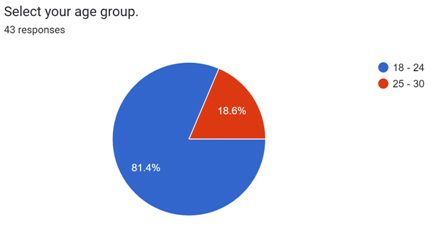
The first question that was asked to the respondents was.
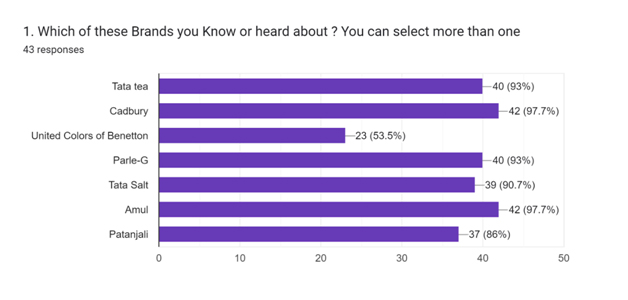
- According to the graph, there were 97.7% of the respondents who heard mainly two brands that is Cadbury and Amul, whereas, 93% of the respondents heard about Tata Tea and Parle-G. This is very clear from the graph that almost everyone is known to these brands except to United colours of Benetton which is known only by 53.5% of respondents.
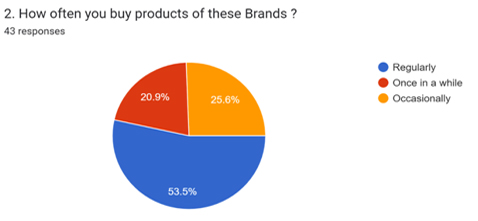
- As the pie chart shows that only 53.5% respondents regularly purchase product of these brands while, 25.6% people occasionally purchase the products of these following brands and only 20.9 % respondents who purchase products once a while. Because these brands are known it’s a huge percentage that can affect the sales of these brands.
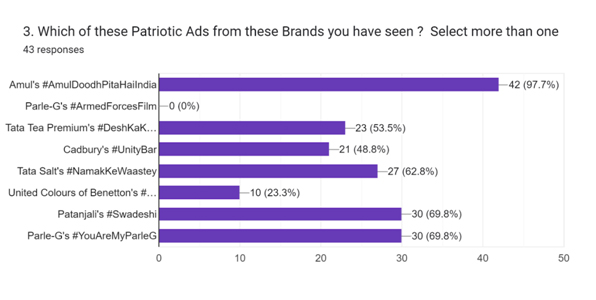
- This graph shows that the respondents that have come across the patriotic ads , the percent is divided as 7% of respondents have seen the Amul’s Patriotic ad with the tagline Amul’s Doodh Peeta Hain India, while 69.8% have seen Parle-G’s and Patanjali’s Paridhan Patriotic ads. This represents that Amul, Parle-G and Patanjali have somewhere succeeded in their plan for brand recognition and evoking Patriotism through their ads.
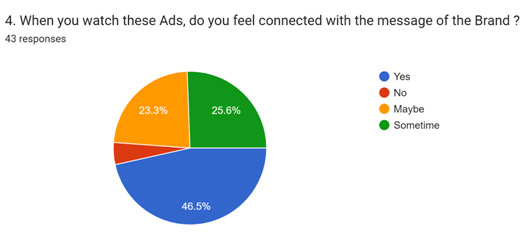
- The main motive of the brands is to connect the audience with their patriotic ads and the results of this question shows that 46.5% respondents feel connected when they watch patriotic advertisements, while only 4.7 % people don’t feel connected to the patriotic ads.
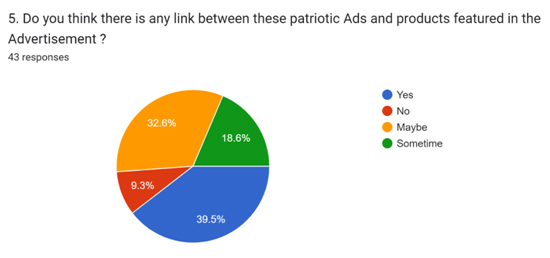
- The answer to the question whether the respondents think of any link between these patriotic ads and product features or not. The responses show that 5% people think there is a link between the ad and the product feature like Patanjali says that the raw material of their products is made in India, Amul’s from its establishment says that it totally and purely made in India and which is true. Brands also started encouraging this tag “MADE IN INDIA” from the time of Prime Minister’s speech in Covid-19 i.e. vocal for local.
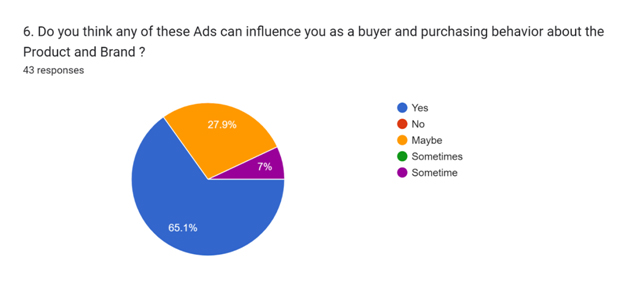
- The above pie chart shows that 65.1% respondents think that these Patriotic ads have the ability to influence a buyer’s perspective and purchasing behavior for the brand and the product, whereas none of the respondents thinks that brands cannot influence the buyer’s perspective and purchasing behavior. It is also because advertising is meant for influencing people’s perspective and purchasing behavior.
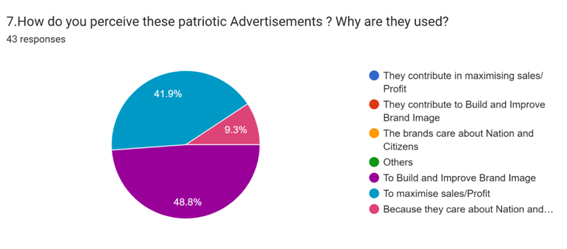
- As the pie chart shows that 48.8% respondents thinks that the reason behind brands patriotic ads is they want to Build or Improve their Brand Image, whereas 41.9% people think that brands release these ads to maximize their sales/profits.
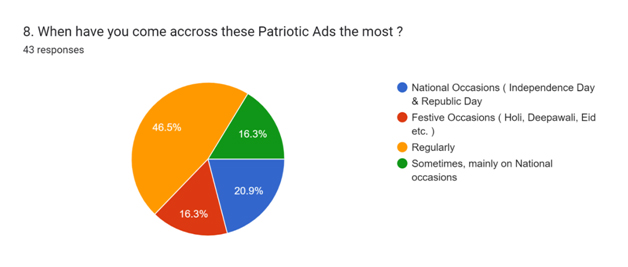
- According to the above pie chart, people with a percentage of 46.5% thinks that these patriotic themed advertisements appears regularly and there is no such specific time for their release. These ads appears regularly in recent time and the reason behind their regular appearance is somewhere Covid-19 period, because at that time it was necessary that people understand its harsh impact and for that many brands play their role as they release ads on patriotic theme.
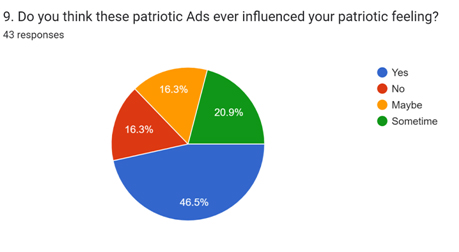
- Ads on patriotic theme have some key motives that includes whether they want to generate awareness, evoke patriotism or maximize their sales and profits. If any one of these motives has been achieved then it is termed to be a big victory for that brand. So here, 46.5% respondents think that these patriotic ads have influenced their patriotic feeling towards the nation.
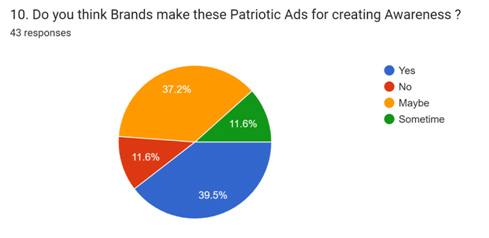
- The answers of the is question shows the variability in the opinions of the respondents, as 39.5% people think that brands make these ads to create awareness whereas 11.6% people do not think anything like that and some people just guessing this and their percentage is 37.2%.
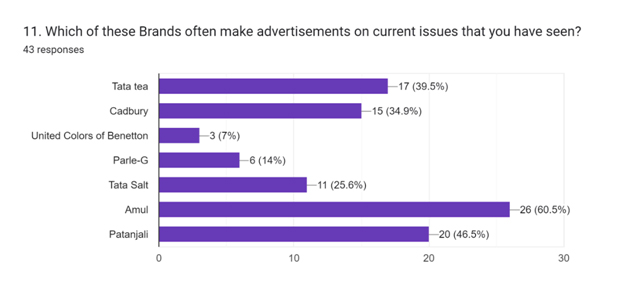
- This question shows that 60.5% respondents thinks that Amul is the brand which makes advertisements more on current issues happening around the nation or globe, and which stands true as Amul became more popular from its spontaneous advertising strategies with similar style, they always come up with arresting agendas which influence the brand image and recall.
Conclusions
The data that has been collected and analysed shows that each respondent has their own view point and experiences that has given a varied data.
The study concludes or points out that Brands uses the patriotic appeal for their brand building and recall. In the process they contribute in enriching the patriotic feelings in the masses too. For further transparency ,primary data analyses shows that Brands mainly uses Patriotic appeals to generate awareness and then to maximize their sales and profits. Some more findings that are analysed includes that most of the younger generation feel connected when they watch ads that are on patriotic theme, they agree to the point that there is a link between brand and product features, it is also found that they also agree to the fact that patriotic ads have the ability to change the perspective and purchasing behaviour of the consumers and at last most of the respondents feels like these advertisements start coming regularly in recent years and not only on National or Festive Occasions, it shows that brands are more interested for making ads on current happenings in the nation rather than on the casual topics. It was also observed that Brands uses patriotic theme along with the combination of emotional, joyful, happiness appeals that adds more effectiveness in the advertisements.
References
- David &Roswinanto, 2014.Can vague brand slogans promote desirable consumer responses. Journal of Product & Brand Management, Vol. 23 Issue: 4/5, pp.282 – 294.
- Demirel, Cagatay and Aslan, Emre S., The Slogan Effect; The power of Brand Discourse in liking and purchasing Behaviour. Media Literacy and Academic Research , Vol. 4, No. 1, April 2021
- Belch et al. (2014) Advertising and Promotion: An Integrated Marketing Communication Perspective. India: McGraw Hill Education
- Mehta, A. (2000). Advertising attitudes and advertising effectiveness. Journal of Advertising Research, pp 67-72.
- Meenaghan, T. (1995). The role of advertising in brand image development. Journal of Product & Brand Management, 4, 23-34.
- Wan-Hsiu Sunny Tsai, Patriotic advertising and the creation of the citizen consumer, Journal Media and Communication Studies Vol. 2(3)pp. 076-084, March, 2010
- https://ivypanda.com/essays/content-analysis-of-advertisements/
- https://www.researchgate.net/publication/276464508_Content_Analysis_of_Advertisements_in_Different_Cultures
- https://doi.org/10.15655/mw%2F2015%2Fv6i1%2F55391
- https://journalofcommunication.ro/oldsite/archive2/030/29/moraru_29.pdf
- https://www.indianjournals.com/ijor.aspx?target=ijor:mw&volume=6&issue=1&article=007
[1]Faculty, Dept. of Advertising and Public Relations, MCNUJC, Bhopal
[2]Alumni 2022 Batch, Dept. of Advertising and Public Relations, MCNUJC, Bhopal

